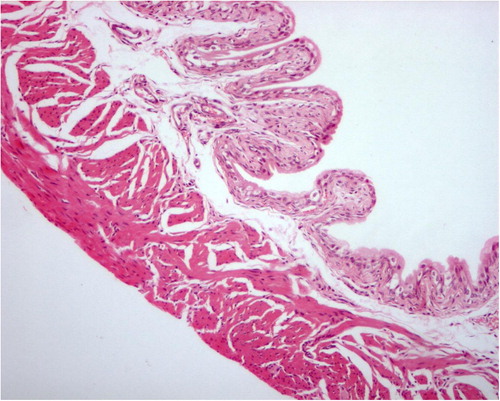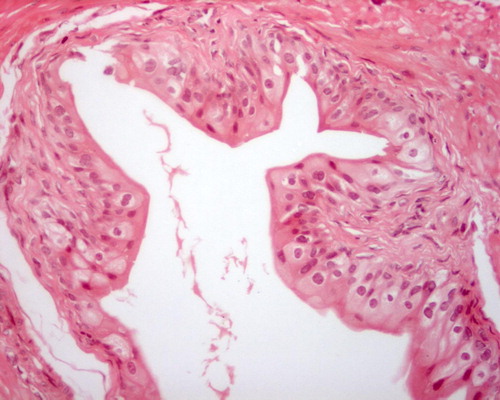Abstract
Cyclophosphamide (CP) is an anti-neoplastic drug, which is widely used for treating cancer and non-malignant tumors. One of the major side effects of CP is hemorrhagic cystitis. Spirulina (Arthrospira platensis; Sp) is a blue-green algae with the ability to attenuate oxidative stress, which may be utilized for alleviating side effects of chemotherapeutic drugs in the clinic. The aim of the present study was to evaluate the ability of Sp, to protect mice from cyclophosphamide-induced urotoxicity and hemorrhagic cystitis due to its antioxidant properties. Adult female mice were orally administered Sp (600 g/kg body weight/day) over nine days as well as a single dose of CP (40 mg/kg body weight) intraperitoneally either four days previously (CP + Sp group) or four days after the start of Sp intake (Sp + CP group); two further groups were treated with either Sp or CP only, respectively. The results showed that CP induced hemorrhagic cystitis in mice, with levels of malondialdehyde (MAD) significantly increased and those of glutathione (GSH) decreased compared with the control group (P < 0.05), while the opposite effects were observed in the mice who received Sp only (P < 0.05). Furthermore, in the CP + Sp group, MAD and GSH levels were improved compared with those in the CP only group, and in the Sp + CP group, the effects of CP were reversed. In addition, histomorphological alterations of the urinary bladder were significantly lower than those in the CP group. In conclusion, pre-treatment with Sp protected mice from CP-induced urotoxicity, probably via its anti-oxidant and anti-apoptotic properties.
Introduction
CyclophoSphamide (CP) has been used in the treatment of certain types of cancer (lymphoma, leukemia and multiple myeloma) and non-malignant diseases such as rheumatoid arthritis [Citation1]. However, CP has numerous adverse effects, a major one being hemorrhagic cystitis (HC), which arises from acute inflammation of the urinary bladder [Citation2,Citation3] . Acrolein, a metabolic product of CP, rapidly reacts at numerous cellular sites and depletes cellular antioxidants [Citation4]. It can also react with certain protein residues and nucleophilic sites of the DNA [Citation5].
In addition, CP has been identified as an initiator of lipid peroxidation [Citation6]. Acrolein, the metabolic product of CP, is a reactive and relatively electrophilic compound, and its high toxicity is associated with its ability to rapidly enter the uroepithelium due to its chemical nature as an un-saturated aldehyde as well as to increase the production of reactive oxygen Species (ROS) in the bladder epithelium [Citation7]. Numerous studies have used anti-oxidants, including α-tocopherol, β-carotene and melatonin [Citation8,Citation9] , as protective agents against CP-induced bladder damage with the elimination of the urotoxicity of CP improving the tolerability of the drug [Citation1].
Spirulina (Sp; ArthroSpira platensis) is a photosynthetic cyanobacterium that possesses biological activity and is widely cultivated for the production of nutritional supplements [Citation10]. Sp has also gained increasing attention from medical scientists as a nutraceutical and source of potential pharmaceuticals. Indeed, numerous active components of Sp, including phycocyanins, tocopherols, β-carotenes and phenolic compounds exhibit antioxidant properties [Citation11]. Sp is rich in fatty acids (linoleic acid, F-linolenic acid and palmitic acid), essential amino acids, selenium (Se) and vitamins A–E [Citation12].
Malondialdehyde (MDA) is formed as a product of free oxygen radicals during oxidative degeneration of lipids [Citation13] and serves as an indicator of oxidative stress [Citation14]. Studies have shown that ROS have an important role in CP-induced HC [Citation3,Citation2] .
Biological systems possess numerous biomolecular agents to protect themselves from damage through free radicals. Glutathione (GSH) is the most abundant intracellular thiol-based anti-oxidant and has an important role in the cellular defense cascade against oxidative injury [Citation15]. GSH, a cofactor for glutathione peroxidase, catalyzes the reduction of hydrogen peroxide to oxygen and water, thereby limiting the formation of hydroxyl radicals, which are highly toxic ROS [Citation16].
The activities of enzyme as antioxidant are dependent on certain metalloenzymes, which in turn require trace elements, micro-nutrients present at very low concentrations (μg/dl) in bodily fluids, to function effectively [Citation17]. Zinc (Zn) and selenium (Se) are examples of trace elements that we include them in our study.
The aim of the present study was to demonstrate, biochemically as well as histopathologically, the toxic effects of CP on the bladder and to assess the capacity of Sp extract to alleviate this side effect.
Materials and methods
Animals
A total of 50 female BALB/C mice (age, 6 weeks; weight, 25–30 g) were obtained from the Animal Resources Unit of the Medical Experimental Research Center (MERC), Faculty of Medicine, Mansoura University (Mansoura, Egypt). The mice were kept under a 12-h light/dark cycle in clean plastic cages with free access to food (standard mouse pellet diet) and water ad libitum. The humidity was kept at 55 ± 10% and the temperature was controlled at 23 ± 1 °C.
All experiments using animals were performed according to the protocol approved by the Intuitional Animal Care and Use Committee at Mansoura University.
Drugs and agents
CP (Endoxa) was purchased from Baxter Oncology Chemical Co. (Egypt) and dissolved in 0.9% NaCl solution to prepare a stock solution, which was intraperitoneally (i.p.) injected into the mice. Sp was provided as a fine dark blue-green powder by the Botany Department Faculty of Science Zagazig University (Zagazig, Egypt) and was dissolved in sterile distilled water to prepare a stock solution which was orally administered to mice using intragastric gavage.
Experimental design
Mice were allocated to five groups (10 mice in each) as follows:
All mice were sacrificed at the end of the 9 days. Blood samples of mice from each group were collected by cardiac puncture on the day of termination. Whole blood was withdrawn from each mouse, 2 ml of which were mixed with ethylenediaminetetraacetic acid for complete blood count using automatic hematology analyzer (Sysmex Corp., Kobe, Japan), and the remaining blood was left to stand in a plain tube for preparation of serum from clotted blood by centrifugation at 2000 rpm for 5 min. Serum was divided into two aliquots and immediately frozen at −70 °C for later assessment of MDA and GSH by ELISA (Calbiotech, Spring Valley, CA, USA; R&D Systems, Minneapolis, MN, USA) and Zn and Se were estimated using atomic absorption Spectroscopy [Citation18].Histological analysis
Following fixing in 10% formalin and embedding in paraffin, tissues were cut into 5-μm sections, mounted on slides and stained with hematoxylin-eosin (H-E) to visualize the general structure of the urinary bladder. The severity of bladder damage was assessed depending on the following phenomena: Edema, hemorrhage, desquamation of epithelial cells and destruction of smooth muscle cells.
Statistical analysis
Differences within groups were analyzed by one-way analysis of variance with SPSS software (version 10; SPSS Inc., Chicago, IL, USA). P < 0.05 was considered to indicate a statistically significant difference. Mean ± standard deviation values were calculated for each group to determine the significance of inter-group differences.
Results
Sp inhibits CP-induced oxidative stress in mice
At the end of the experiment (day 9), the serum MDA levels in the CP group were significantly higher than those in the control group, while those in the Sp group were significantly lower than those in the CP group (P < 0.05). Furthermore, serum GSH levels in the Sp group were significantly elevated, while those in the CP group were significantly reduced compared with those in the control group (P < 0.05) ().
Table 1 Serum MDA, GSH, Se and Zn levels in the experimental groups at day 9.
Sp attenuates Cp-induced reduction of Zn and Se levels in mice
Administration of CP alone caused a significant drop in the serum levels of Zn and Se of the mice (P < 0.05). By contrast, treatment with Sp alone significantly elevated the serum levels of Zn and Se (). Ingestion of Sp (600 mg/kg) after CP significantly improved the lowered levels of Zn and Se compared with those in the CP group; however, they remained below their correSponding control levels. Administration of Sp prior to CP caused further elevations in serum Zn and Se levels, while they were still slightly below their correSponding control levels ().
Sp reduces or prevents CP-induced reduction of hematological parameters in mice
Laboratory analysis of the blood of the mice on day 9 revealed that the red blood cell count (RBCs), hemoglobin (Hb) concentration, platelet count and white blood cell count (WBCs) in CP-treated mice were all significantly reduced in comparison with those in the control mice (P < 0.05) (). Oral administration of Sp at 600 mg/kg in mice previously injected with CP significantly improved the platelet count and WBCs as well as the Hb concentration, while the RBC count was not significantly affected. Furthermore, if Sp was administered prior to CP, the improvement in the four hematological parameters was more significant and their levels nearly approached the control levels.
Table 2 Hematological parameters in each experimental group.
However, four hematological parameters did not significantly affect by administration of Sp only when compared with those in the control mice ().
Sp prevents CP-induced damage to bladder tissues of mice
Histopathological analysis revealed that the damage to the urinary bladder in the CP group was highest among all groups. Of note, in the SP + CP group, the damage was reduced compared with that in the CP group. In the control and Sp groups, the structure of the bladder tissues was normal. The normal urinary bladder wall was composed of the urothelium formed by firmly stuffed transitional cells showing the superficial umbrella cells with minimal intercellular Space. The basement membrane which separates the epithelium from the underlying lamina propria was intact. The mucosa was thrown into folds and there was no exudate in the lumen ( and ).
Fig. 1b A urinary bladder from a mice received Spirulina only showing normal mucosa of the urinary bladder (Hx&Ex200).
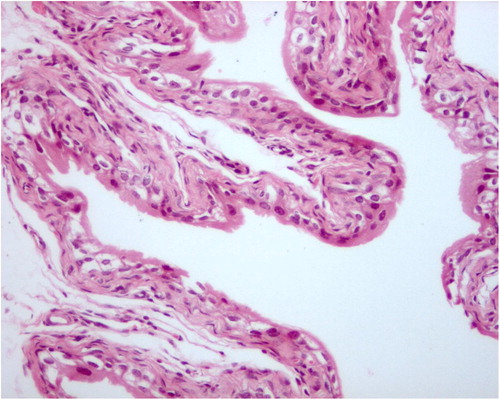
By contrast, the bladder wall in CP-treated animals showed severe damage with desquamation of the surface epithelium. Marked edema in the lamina propria and cloudy swelling of the epithelial cells were observed, as well as inflammation in the mucosal and the sub-urothelial connective tissues of the urinary bladder, leading to vascular damage and subsequent bleeding followed by formation of granulation tissue (–D).
Fig. 2a A urinary bladder from a mice received only cyclophoSphamide showing interstitial haemorrhage (Hx&Ex200).
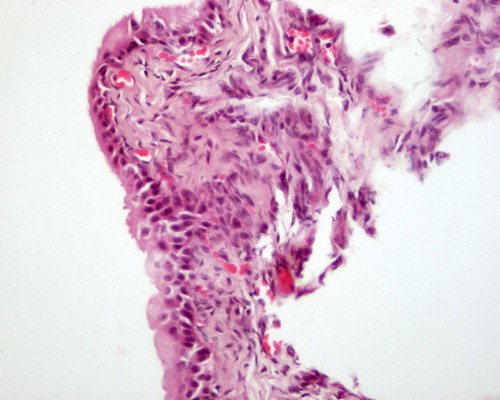
Fig. 2b A urinary bladder from a mice received only cyclophoSphamide showing marked edema and epithelial desquamation (Hx&Ex200).
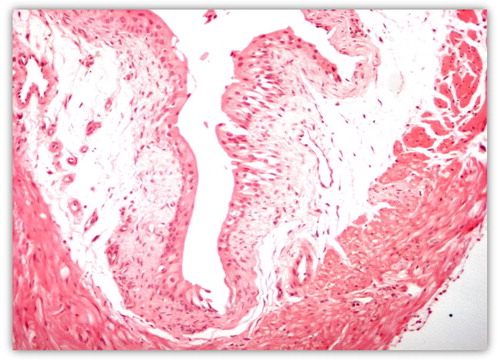
Fig. 2c A urinary bladder from a mice received only cyclophoSphamide showing marked edema and cloudy swelling of the epithelial cells (Hx&Ex200).
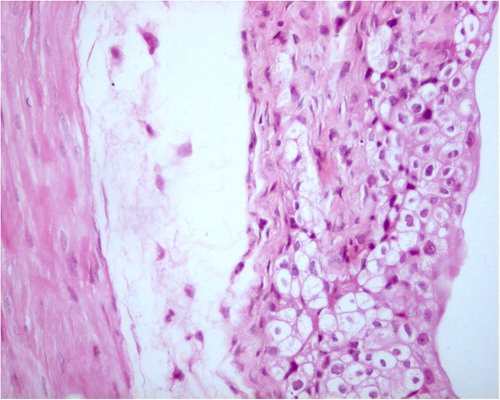
In the group administered SP after CP injection, the bladder walls in most mice showed was normal (); however, certain mice showed partially desquamated epithelium (). Others showed enlarged hyperchromatic nuclei of the transitional cells and hyperplasia of the basal cells, which indicates attempts of repair ( and ).
Fig. 3a A urinary bladder in a mice received cyclophoSpamide followed by Spirulina showing normal structure (Hx&Ex200).
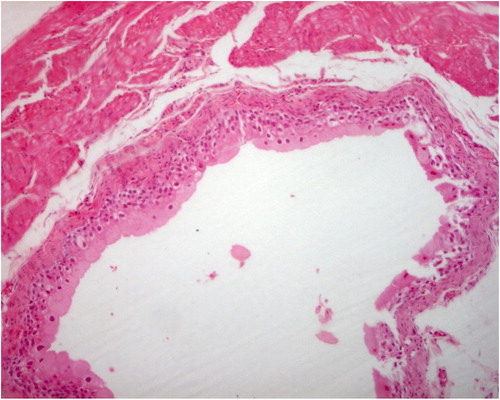
Fig. 3b A urinary bladder in a mice received cyclophoSpamide followed by Spirulina showing desquamated epithelial cells.
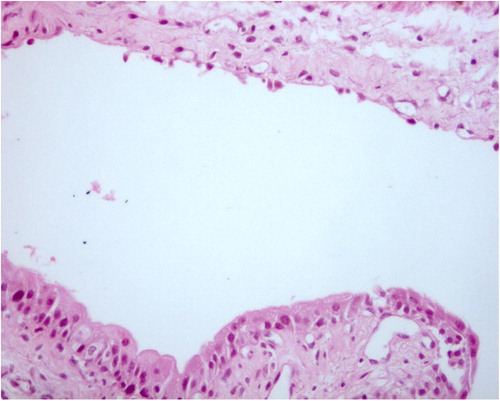
Fig. 3c A urinary bladder in a mice received cyclophoSphamid followed by Spirulina showing epithelial cells with large hyperchromatic nuclei which suggest attempt for healing (H&Ex200).
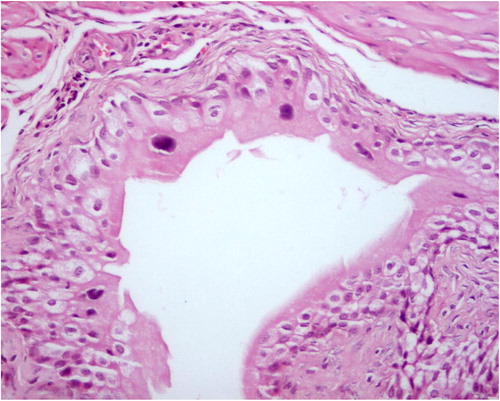
Fig. 3d A urinary bladder in a mice received cyclophoSphamid followed by Spirulina showing epithelial cells with large hyperchromatic nuclei which suggest attempt for healing (H&Ex200).
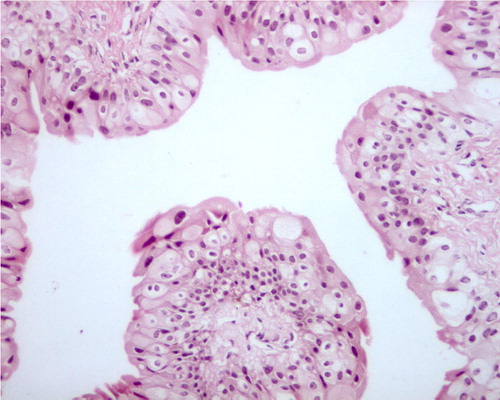
In the Sp pre-treatment group, the urinary bladder showed a normal structure without any histopathological changes ().
Discussion
CP belongs to a class of alkylating agents known as nitrogen mustard derivatives. It is a common immunosuppressive and chemotherapeutic agent used for the treatment of certain autoimmune diseases and a wide range of neoplasms, also in combination with other drugs [Citation19]. In patients receiving CP for the treatment of solid tumors, leukemia or lymphomas or for conditioning prior to bone marrow or stem cell tranSplantation, side effects are well known.
CP is one of the most damaging alkylating agents that can cause oxidative stress due to the over-production of ROS [Citation19,Citation20,Citation7] . It affects the DNA of replicating and rapidly multiplying cells particularly in the gonads and pituitary, which results in miscoding, crosslinking and DNA breakage by transferring alkyl groups to the guanine components of DNA [Citation21]. A potential approach to interfere with CP-induced toxicity is to lower the induced oxidative stress.
Acrolein is a metabolic product of CP and its effects on tubular and urinary bladder epithelium are the first manifestation of CP-induced toxicity in addition to the excessive generation of free oxygen radicals through the principal alkylating metabolite of CP, intracellular phoSphoramide mustard [Citation22Citation[23]–Citation24] . The tolerance of CP can be improved by eliminating its side effects to achieve a more proficient treatment for patients requiring CP treatment.
Sp is one of the most widely used herbal medicines for the treatment of various diseases. The pharmacological properties of Sp have been reported to include anti-inflammatory, anti-cancer, anti-diabetic, anti-microbial, anti-histaminic, anti-infertility and hypotensive effects [Citation25]. Clinical trials have shown that Sp can serve as a supplementary cure for numerous diseases as well as improving immunological function; Sp has also been used in health foods, animal feed and for biochemical products since the 1980s [Citation26].
MDA is an end-product of lipid peroxidation, which is a free radical-mediated process. It may be used as an indicator of oxidative stress and increases in the body after administration of CP. MDA resulting from increased lipid peroxidation in aberrantly proliferating cells is known to be secreted into the circulating blood, leading to increased MDA levels in cancer patients. In line with these results, the present study showed that MDA levels were increased and that HC and bladder toxicity were induced by CP administration in mice. Sp has multiple active component, including superoxide dismutase, vitamin E, carotene, chlorophyll, B-complex vitamins and numerous minerals, these components may be accountable for the tissue protective properties of Sp [Citation26]. In addition, C-phycocyanin, a protein-bound pigment found in Sp, prevents renal injury by inhibiting oxalate-mediated lipid peroxidation [Citation27]. Furthermore, it inhibits apoptotic death of pancreatic cells by enhancing the GSH and SOD peroxidase enzymes to prevent the overproduction of ROS [Citation28].
The present study revealed that after CP treatment, MDA, an indicator of oxidative stress, was markedly increased in urinary bladders mice, suggesting that it caused oxidative damage to the proteins and lipids in this organ. In the Sp + CP group, MDA levels were significantly lower than those in the CP group but were not significantly different from those in the control group (P > 0.05). It was therefore indicated that pre-treatment with Sp prevented CP-induced elevation of MDA.
Increases in the levels of anti-oxidant enzyme GSH in mice treated with Sp indicated it is protective effects by enhancing the cells’ anti-oxidant capacity. While GSH was significantly reduced following CP treatment, GSH levels in the CP + Sp group were comparatively higher and those in the Sp + CP group were even higher (P < 0.05). Therefore, Sp was indicated to be a potent inhibitor of CP-induced lipid peroxide formation.
The protective effects of Sp against CP-induced acute urotoxicity in mice are associated with its anti-oxidant properties. Moreover, the protective effects of Sp may be due to a decrease in oxidative stress via reduction of the accumulation of protein-acrolein adducts. This can be explained by the free radical scavenging properties of the Sp. CP-induced histopathological changes in the urinary bladder were observed to be prevented by pre-treatment with Sp [Citation29].
Zn and Se have a vital role in numerous physiological processes, including the function of the immune system, and the development and healing of inflammatory tissue lesions. Se has been shown to have a positive effect on the outcome of cancer and infectious diseases [Citation30], whereas a deficiency of Zn may negatively affect the immune system and cell growth. In the present study, Sp ingestion increased the concentration of Zn and Se in the blood of mice compared with that in CP-treated mice, indicating that supplementation with Se and Zn contained in Sp may have a role in alleviating CP-associated toxicity.
The present study revealed that RBCs, Hb, WBCs and platelets were significantly decreased in mice receiving CP. These findings were in agreement with those of other studies, which reported that CP induces leukopenia in mice [Citation31]. The anemia found in CP-treated mice may be of the type caused by chronic disease; however, other causes include autoimmune hemolytic anemia, iron deficiency anemia, anemia of chronic renal failure and CP-associated myelotoxicity. Thrombocytopenia occurs in CP-treated mice and it is part of a broader hematological disturbance. In the present study, all of these disturbances of hematological parameters were alleviated by Sp treatment, since Hb, RBCs, WBCs and platelet count were increased compared to those in CP-treated mice. These findings are in good agreement with the result of a previous study, which reported that Sp supplementation in drinking water for 30 days induced significant increases of RBCs and Hb in rats [Citation32]. It was also found that disturbances of hematological parameters were attenuated to a greater extent if Sp was given prior to CP rather than thereafter, which indicates that Sp may have a marked effect on the process of erythropoiesis. However, Sp treatment alone did not significantly affect any of these hematological parameters compared to those in the control group.
These findings suggested that Sp may also protect against toxicity induced by other chemotherapeutic agents whose mechanisms of action are similar to that of CP. Finally, chronic CP-associated urotoxicity may be alleviated by Sp. The combination of CP with a potent anti-oxidant may be appropriate to reduce its urotoxicity, which was supported by the results of the present study on the treatment of CP-induced mice with Sp.
The positive effects of Spirulina in allergic rhinitis are based on adequate evidence but larger trials are required. It is believed that the anticancer effects of Spirulina are perhaps derived from β-carotene, a known antioxidant; however, the link between β-carotene level and carcinogenesis cannot be established as the etiology of carcinoma is frequently multifactorial [Citation33,Citation34] . There are some positive studies on the cholesterol-lowering effects of Spirulina but larger studies are required before any definitive conclusions can be made. Finally, there are no high-level evidence trials on the role played by Spirulina in chronic fatigue and in antiviral applications. At the moment, what the literature suggests is that Spirulina is a safe food supplement without significant side-effects but its role as a drug remains to be seen.
CP treatment is associated with an increased risk of HC and bladder cancer, while the effectiveness of Sp in preventing cystitis is largely based on its anti-oxidant properties. In the present study, the anti-oxidants GSH, Zn and Se were significantly reduced in CP-treated but elevated in Sp-treated mice; however, CP caused an elevation of MDA levels as well as severe damage to the urinary bladder. The present study showed that Sp protected from CP-induced urotoxicity and hemorrhagic cystitis, probably due to its anti-oxidant and anti-apoptotic properties. Thus, Sp can be recommended as a food supplement to alleviate the side effects of numerous drugs and to stimulate the immune system of drugs users.
Acknowledgements
The authors would like to thank all of the staff of the MERC of Mansoura University.
References
- C.DolleryCyclophoSphamideC.DolleryTherapeutic drugs1999Churchill LivingstoneEdinburg349353
- T.M.WongW.YeoL.W.ChanT.S.MokHemorrhagic pyelitis, ureteritis, and cystitis secondary to cyclophoSphamide: case report and review of literatureGynecolOncol762000223225
- R.D.WalkerH.SommerkampHemorrhagic cystitis after high dose chemotherapy. An interdisciplinary problemUrologie A371998516521
- A.OzcanA.KorkmazS.OterO.CoskunA: contribution of flavonoid antioxidants to the preventive effect of mesna in cyclophoSphamide-induced cystitis in ratsArch Toxicol792005461465
- V.L.SouliotisM.A.DimopoulosP.P.S fikakisGene Specific formation and repair of DNA monoadducts and interstrand cross-links after therapeutic exposure to nitrogen mustardsClin Cancer Res9200344654474
- J.D.AdamsL.K.KlaidmanAcrolein-induced oxygen radical formationFree Radic Biol Med1521993187193 PMID: 8397144
- F.Q.AlenziY.S.El-BolkinyM.L.SalemProtective effects of Nigella sativa oil and thymoquinone against toxicity induced by the anticancer drug cyclophoSphamideBr J Biomed Sci67120102028
- G.SenerO.SehirliB.C.YegenS.CetinelN.GedikA.SakarcanMelatonin attenuates ifosfamide-induced Fanconi syndrome in ratsJ. Pineal ResAug37120041725 PMID: 15230864
- T.TopalY.OztasA.KorkmazS.SadirS.OterO.CoskunMelatonin ameliorates bladder damage induced by cyclophoSphamide in ratsJ Pineal Res3842000272277 PMID: 15813904
- M.F.Mc CartyClinical potential of Spirulina as a source of phycocyanobilinJ Med Food1042007566570
- D.K.HeylandR.DhaliwalU.SuchnerM.M.BergerAntioxidant nutrients: a systematic review of trace elements and vitamins in the critically ill patientIntens Care Med3132005327337
- P.C.DartschAntioxidant potential of selected Spirulina platensis preparationsPhytother Res2252008627633
- F.NeilsenB.B.MikkelsenJ.B.NeilsenH.R.AndersenP.GrandjeanPlasma malondialdehyde as biomarker for oxidative stress: reference interval and effects of life-style factorsClin Chemist47199712091214
- A.ValenzuelaThe biological significance of malondialdehyde determination in the assessment of tissue oxidative stressLife Sci481990301309
- M.JafariM.SalehiS.AhmadiA.AsgariM.AbasnezhadM.HajigholamaliThe role of oxidative stress in diazinon-induced tissues tox-icity in Wistar and Norway ratsToxicol Mech Methods222012638647
- C.H.HsuB.C.ChiM.Y.LiuJ.H.LiC.ChenR.Y.J and ChenPhoSphine-induced oxidative damage in rats: role of glutathioneToxicology179200218
- F.E.UbohM.I.AkpanabiatuY.AlozieComparative effects of vitamins A and E on gasoline vapour induced haematotoxicity and weight loss in male ratsInt J Pharmacol532009215221
- W.I.MortadaM.M.HassanienA.A.EL-AsmySpeciation of platinum in blood, plasma and urine by micelle-mediated extraction and graphite furnace atomic absorption SpectrometryTrace Elem Medb Biol272013267272
- Pryor JL, Hughes C, Foster W, Hales BF, Robaire B. Critical windows of exposure for children’s health. Environ. Health PerSp 2000;108(3):491–503.
- D.C.MitchellS.L.NiuB.J.LitmanEnhancement of G protein-coupled signaling by DHA phoSpholipidsLipids382003437443
- K.BeckerJ.SchoneichExpression of genetic damage induced by alkylating agents in germ cells of female miceMutat Res921–21982447464
- P.AbrahamS.RabiD.SelvakumarProtective effect of aminoguanidine against oxidative stress and bladder injury in cyclophoSphamide-induced hemorrhagic cystitis in ratCell Biochem Funct2720095662
- S.SadirS.DeveciA.KorkmazAlpha tocopherol, beta carotene, and melatonin administration protects cyclophoSphamide induced oxidative damage to bladder tissue in ratsCell Biochem Funct252007521552
- Y.A.AsiriProbucol attenuates cyclophoSphamide-induced oxidative apoptosis, p53 and Bax signal expression in rat cardiac tissuesOxid Med Cell Longev32010308316
- Z.Zhi-gangL.Zhi-liL.Xue-xianStudy on the isolation, purification and antioxidation properties of polysaccharides from Spirulina maximaActa BotanicaSinica3919977781
- Becker EW. Microalgae. In: Nutrition. Cambridge: Cambridge University; 1988. p. 196–249.
- Schwerdt G, Gordjani N, Benesic A. Chloroacetaldehydeandacrolein-induced death of human proximal tubule cells. PediatrNephrol 2006;21(1):60–7.
- P.MuthuramanR.SenthilkumarK.SrikumarAlterations in betaislets of langerhans in alloxan-induced diabetic rats by marine Spirulina platensisJ Enzyme Inhib Med Chem246200912531256
- K.F.GeyVitamins E plus C and interacting conutrients required for optimal health. A critical and constructive review of epidemiology and supplementation data regarding cardiovascular disease and cancerBiofactors Biofactors71998113174
- M.P.RaymanSelenium in cancer prevention: a review of the evidence and mechanism of actionProcNutrSoc642005527542
- G.C.HuangL.S.WuL.G.ChenL.L.YangC.C.WangImmuno-enhancement effects of Huang Qi Liu Yi Tang in amurine model of cyclophoSphamide-induced leucopeniaJ Ethnopharmacol1092007229235
- N.SimsekA.KaradenizY.KalkanO.N.KelesB.UnalSpirulinaplatensis feeding inhibited the anemia and leucopeniainduced Lead and cadmium in ratsJ Hazar Mat164201013041309
- N.MalilaJ.VirtamoM.VirtanenP.PietinenD.AlbanesL.TeppoDietary and serum alpha-tocopherol, beta-carotene and retinol, and risk for colorectal cancer in male smokersEur J Clin Nutrition562002615621
- K.LiedeJ.HietanenL.SaxenJ.HaukkaT.TimonenR.Hayrinen-Immonenet al.Long-term supplementation with alpha-tocopherol and beta-carotene and prevalence of oral mucosal lesions in smokersOral Diseases419987883

